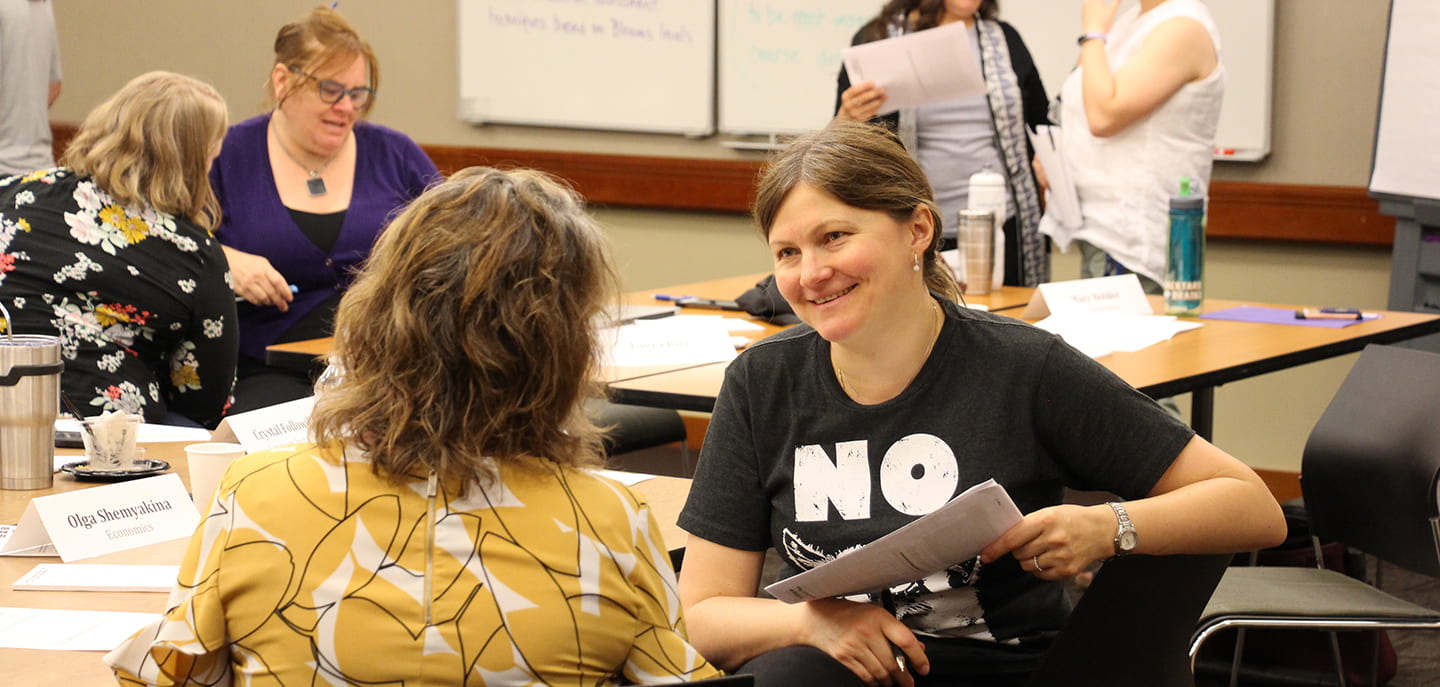Course Design Studio 2019

After participating in Course Design Studio, Dr. Mary Holder, Academic Professional in Psychology and Neuroscience, reflected that “I feel like I am in good shape to start redesigning my course such that the assessments, objectives, and content are all aligned.”
 The Course Design Studio is one of the Center for Teaching and Learning‘s (CTL) most impactful programs. It has been held annually each summer since 2012. This year, Dr. Carol Subiño Sullivan, Assistant Director of Faculty Teaching and Learning Initiatives, and Dr. Kate Williams, Assistant Director of TA Development and Future Faculty Initiatives, co-facilitated the program from May 15-21, 2019. Seventeen faculty members spent twelve hours over four sessions designing or redesigning their courses. At each session, participants applied principles of course development to the courses they were (re)designing and received feedback on ideas from their colleagues and CTL consultants.
The Course Design Studio is one of the Center for Teaching and Learning‘s (CTL) most impactful programs. It has been held annually each summer since 2012. This year, Dr. Carol Subiño Sullivan, Assistant Director of Faculty Teaching and Learning Initiatives, and Dr. Kate Williams, Assistant Director of TA Development and Future Faculty Initiatives, co-facilitated the program from May 15-21, 2019. Seventeen faculty members spent twelve hours over four sessions designing or redesigning their courses. At each session, participants applied principles of course development to the courses they were (re)designing and received feedback on ideas from their colleagues and CTL consultants.
“We structured the Course Design Studio so that it guides faculty through the backwards course design process,” explained Subiño Sullivan, “Participants start by defining their learning objectives. Then they identify the assessments that will measure student mastery of those objectives. Then, finally, they plan the learning activities that will prepare students for success on the assessments. The result should be a class whose elements are well-aligned.”

Participants are given the opportunity to discuss and develop their courses amongst peers under the guidance of Dr. Subiño Sullivan and Dr. WIlliams in an environment structured similarly to a seminar with clear learning objectives set for each session.
Day 1: Course Vision and Learning Objectives
- Consider best practices for effective course design
- Articulate your vision for the type of learning environment and learning outcomes you want your course to support
- Write clear, measurable learning objectives that express the skills students will need to master the course content
- Identify the prior knowledge students need to achieve course learning objectives
 Day 2: Deriving Content and Assessment
Day 2: Deriving Content and Assessment
- Define mastery of content in your course by breaking down the learning objectives into component skills
- Identify content that is aligned with and derived from the course learning objectives
- Identify options for assessment that measure student mastery of content at each level of Blooms
Day 3: Integrating Assessment
- Design formative and summative assessments that measure student mastery
- Create a comprehensive assessment plan that is aligned with course learning objectives and provides ample feedback for students as they work towards mastery
- Incorporate early course feedback in to your course, and plan to make adjustments to your course in response to student feedback
- Consider the features of course policies and grading structures that make them equitable and use these ideas to construct a fair grading system

Day 4: Learning Activities and The Big Picture
- Discuss the effects of active learning in the classroom
- Identify effective teaching strategies and learning activities that support student learning and create a positive, inclusive learning environment for both student and professor alike
- Reflect on your newly-(re)designed courses as a whole and identify next steps for completing your course design
Instructors have found the Course Design Studio to be helpful. Dr. Crystal Followill, a lecturer in the Language Institute, says, “Too often professors think in terms of giving information to students, but [Course Design Studio] helps us think in bigger terms of what we want to see in our classroom, such as passion for learning and life-long learning, things that we sometimes forget about as teachers. The program really helped us to develop our courses from the perspective of our students, thinking about their prerequisites to the course and what their needs are for them to be successful.”
The Center for Teaching and Learning’s next offering of Course Design Studio will be in summer 2020. In the meantime, here are a few resources about course design.
Books:
- Fink, L. Dee. 2003. Creating Significant Learning Experiences: An Integrated Approach to Designing College Courses. Jossey-Bass: San Francisco, CA.
- Hanstedt, Paul. 2018. Creating Wicked Students: Designing Courses for a Complex World. Stylus: Sterling, VA.
- Wiggins, Grant and Jay McTighe. 2005. Understanding by Design. Expanded 2nd Edition. Association for Supervision and Curriculum Development: Alexandria, VA.
-
- See also this guide to Wiggins and McTighe prepared by the University of Vanderbilt’s Center for Teaching: https://cft.vanderbilt.edu//cft/guides-sub-pages/understanding-by-design/
Websites:
- “Developing your syllabus” Center for Teaching and Learning, Georgia Tech. http://ctl.gatech.edu/resources/syllabus
-
- Includes a syllabus template, list of instructional dates, and other helpful tips for designing an effective syllabus.
- “Transparency in Learning and Teaching Project” Mary-Ann Winkelmess, University of Las Vegas, Nevada https://www.unlv.edu/provost/transparency
-
- Includes templates for setting up learning objectives, assignments and grading policies that help students understand how each element of the course contributes to their learning.
- “Course Design and Planning” Center for Research on Learning and Teaching, University of Michigan. http://www.crlt.umich.edu/tstrategies/tscdp
-
- Includes a collection of links to helpful course design resources.
If you would like to meet with someone from the Center for Teaching and Learning to talk about any course design related questions, please contact Dr. Carol Subiño Sullivan at csubino@gatech.edu.




